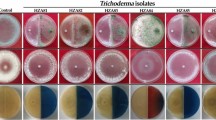Abstract
The effects ofSclerotinia sclerotiorum live and autoclaved sclerotia, and sclerotial exudates, and commercial oxalic acid were testedin vitro on sevenConiothyrium minitans strains differing in aggressiveness towardsS. sclerotiorum. Only sclerotial exudates and autoclaved sclerotia affected the mycelial growth rate of almost all the strains tested, whereas a change in theC. minitans mycelial growth pattern was observed in the presence of autoclaved sclerotia and live sclerotia germinating by the myceliogenic eruptive germination. In addition, sclerotial exudates had a stimulatory effect on spore germination. These findings indicate that the various treatments could influence theC. minitans strains regardless of their aggressiveness.
Similar content being viewed by others
References
Bradford, M. (1976) A rapid sensitive method for the quantitation of microgram quantities of protein utilizing the principle of protein-dye binding.Anal. Biochem. 72:248–254.
Bruehl, G.W. (1987) Soilborne Plant Pathogens. Macmillan Publishing Company, New York, NY. pp. 168–183.
Campbell, W.A. (1947) A new species ofConiothyrium parasitic on sclerotia.Mycologia 39:190–195.
Coley-Smith, J.R., Ghaffar, A. and Javed, Z.U.R. (1974) The effect of dry conditions on subsequent leakage and rotting of fungal sclerotia.Soil Biol. Biochem. 6:307–312.
Colotelo, N., Sumner, J.L. and Voegelin, W.S. (1971) Chemical studies on the exudates and developing sclerotia ofSclewtinia sclerotiorum (Lib.) deBary.Can. J. Microbiol. 17:1189–1194.
Cooke, R.C. (1969) Changes in soluble carbohydrates during sclerotium formation bySclewtinia sclerotiorum andS. trifoliorum.Trans. Br. Mycol. Soc. 53:77–86.
Dutton, M.V. and Evans, C.S. (1996) Oxalate production by fungi:its role in pathogenesis and ecology in the soil environmentt.Can. J. Microbiol. 42:881–895.
Ghaffar, A. (1976) Inhibition of fungi as affected by oxalic acid production bySclerotium delphinii.Pak. J. Bot. 8:69–73.
Gracia-Garza, J.A., Bailey, B.A., Paulitz, T.C., Lumsden, R.D., Releder, R.D. and Roberts, D.P. (1997) Effect of sclerotial damage ofSclewtinia sclerotiorum on the mycoparasitic activity ofTrichoderma hamatum.Biocontrol Sci. Technol. 7:401–413.
Grendene, A. and Marciano, P. (1995)Coniothyrium minitans—Sclerotinia sclerotiorum interaction.Proc. Int. Congr. Microbial Control Agents in Sustainable Agriculture: Field Experience, Industrial Production and Registration (Saint Vincent, Italy), p. 179.
Grendene, A. and Marciano, P. (1995) Virulenza di isolati diConiothyrium minitans, iperparassita diSclerotinia sclerotiorum.Mic. Ital. 3:100–104.
Han, N.S. and Robyt, J.F. (1998) Separation and detection of sugars and alditols on thin-layer chromatography.Carbohydr. Res. 313:135–137.
Le Tourneau, D. (1966) Trehalose and acyclic polyols in sclerotia ofSclerotinia sclerotiorum.Mycologia 58:934–942.
Nelson, N. (1944) A photometric adaptation of the Somogy method for determination of glucose.J. Biol. Chem. 153:375–380.
Sandys-Winsch, C., Whipps, J.M., Gerlagh, M. and Kruse, M. (1993) World distribution of the sclerotial mycoparasiteConiothyrium minitans.Mycol. Res. 97:1175–1178.
Smith, I. (1969) pp. 311–314.in: Smith, I. [Ed.] Chromatographic and Electrophoretic Techniques. Vol. I. Chromatography. W. Heinemann, Medical Books Ltd., Oxford, UK.
Trutmann, P., Keane, P.J. and Merriman, P.R. (1980) Reduction of sclerotial inoculum ofSclerotinia sclerotiorum withConiothyrium minitans.Soil Biol. Biochem. 12:461–465.
Whipps, J.M. and Gerlagh, M. (1992) Biology ofConiothyrium minitans and its potential for use in disease biocontrol.Mycol. Res. 96:897–907.
Whipps, J.M., Grewal, S.K. and Van der Goes, P. (1991) Interaction betweenConiothyrium minitans and sclerotia.Mycol. Res. 95:295–299.
Author information
Authors and Affiliations
Corresponding author
Rights and permissions
About this article
Cite this article
Grendene, A., Marciano, P. Interaction betweenSclerotinia sclerotiorum andConiothyrium minitans strains with different aggressiveness. Phytoparasitica 27, 201–206 (1999). https://doi.org/10.1007/BF02981459
Received:
Revised:
Issue Date:
DOI: https://doi.org/10.1007/BF02981459




